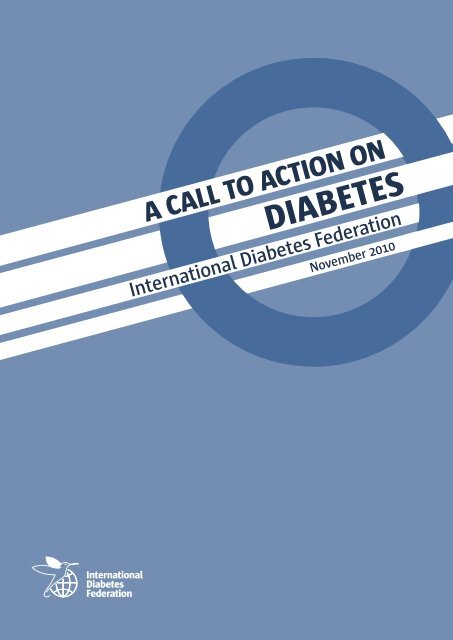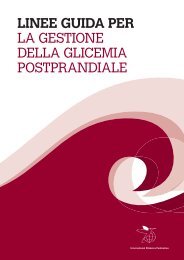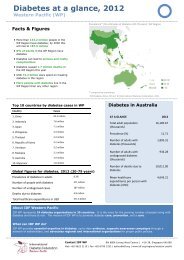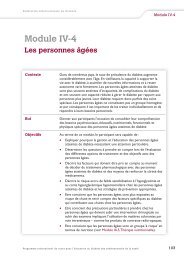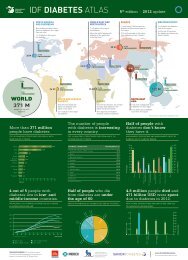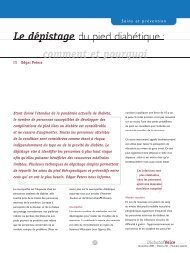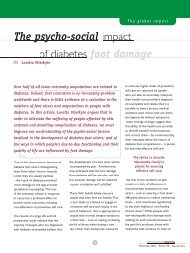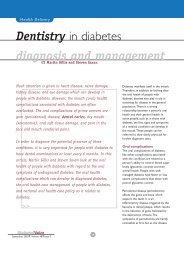Call to Action on Diabetes - International Diabetes Federation
Call to Action on Diabetes - International Diabetes Federation
Call to Action on Diabetes - International Diabetes Federation
You also want an ePaper? Increase the reach of your titles
YUMPU automatically turns print PDFs into web optimized ePapers that Google loves.
A CALL TO ACTION ON<br />
DIABETES<br />
November 2010<br />
Internati<strong>on</strong>al <strong>Diabetes</strong> Federati<strong>on</strong>
FOREWORD by IDF President, Jean Claude Mbanya<br />
No country is immune <str<strong>on</strong>g>to</str<strong>on</strong>g> diabetes. No country has all the answers <str<strong>on</strong>g>to</str<strong>on</strong>g> this comm<strong>on</strong> enemy.<br />
No country has yet managed <str<strong>on</strong>g>to</str<strong>on</strong>g> reverse the rising prevalence. Defeating diabetes will take<br />
every ounce of commitment and ingenuity that we can summ<strong>on</strong>.<br />
<strong>Diabetes</strong> is <strong>on</strong>e of the four priority n<strong>on</strong>communicable<br />
diseases (NCDs) identified by<br />
the World Health Organizati<strong>on</strong> (WHO), al<strong>on</strong>g<br />
with cardiovascular disease, cancer and chr<strong>on</strong>ic<br />
respira<str<strong>on</strong>g>to</str<strong>on</strong>g>ry diseases. It is a chr<strong>on</strong>ic, incurable,<br />
costly, and increasing but largely preventable<br />
NCD which is resp<strong>on</strong>sible for milli<strong>on</strong>s of deaths<br />
annually, debilitating complicati<strong>on</strong>s, and<br />
incalculable human misery.<br />
Over 300 milli<strong>on</strong> people worldwide have<br />
diabetes now. If nothing is d<strong>on</strong>e, this will rise <str<strong>on</strong>g>to</str<strong>on</strong>g><br />
500 milli<strong>on</strong> within a generati<strong>on</strong>. Failure <str<strong>on</strong>g>to</str<strong>on</strong>g> act<br />
now c<strong>on</strong>demns our children and their children<br />
<str<strong>on</strong>g>to</str<strong>on</strong>g> a future of ill-health and poverty. Yet there is<br />
no sense of urgency or public outrage. Future<br />
generati<strong>on</strong>s will demand an explanati<strong>on</strong> for why<br />
we sleepwalked in<str<strong>on</strong>g>to</str<strong>on</strong>g> this global catastrophe.<br />
This <str<strong>on</strong>g>Call</str<strong>on</strong>g> <str<strong>on</strong>g>to</str<strong>on</strong>g> <str<strong>on</strong>g>Acti<strong>on</strong></str<strong>on</strong>g> brings four headline<br />
messages <str<strong>on</strong>g>to</str<strong>on</strong>g> the world from the global<br />
diabetes community:<br />
<strong>Diabetes</strong> is a major global threat<br />
<str<strong>on</strong>g>to</str<strong>on</strong>g> human security and prosperity.<br />
<strong>Diabetes</strong> kills and disables, impoverishes<br />
families, imposes a huge ec<strong>on</strong>omic<br />
burden <strong>on</strong> governments and business,<br />
and overwhelms health systems. It affects<br />
rich and poor, young and old. The majority<br />
of people with diabetes are in low- and<br />
middle-income countries and have<br />
limited access <str<strong>on</strong>g>to</str<strong>on</strong>g> affordable treatment.<br />
The global failure <str<strong>on</strong>g>to</str<strong>on</strong>g> invest in<br />
diabetes has led <str<strong>on</strong>g>to</str<strong>on</strong>g> the current crisis.<br />
The evidence of the magnitude of diabetes<br />
and acceptance that acti<strong>on</strong> is necessary<br />
has been largely ignored by policy<br />
makers. Serious investment is needed<br />
now in essential diabetes medicines and<br />
technologies, proven diabetes management<br />
and care, and research in<str<strong>on</strong>g>to</str<strong>on</strong>g> the causes of<br />
diabetes and a cure.<br />
2 | A <str<strong>on</strong>g>Call</str<strong>on</strong>g> <str<strong>on</strong>g>to</str<strong>on</strong>g> <str<strong>on</strong>g>Acti<strong>on</strong></str<strong>on</strong>g> <strong>on</strong> <strong>Diabetes</strong><br />
The news is bad but we have the<br />
soluti<strong>on</strong>s.<br />
Most diabetes can be prevented or<br />
delayed. Investment in preventi<strong>on</strong> makes<br />
ec<strong>on</strong>omic sense. Effective, low-cost<br />
treatments and care exist for diabetes that<br />
cannot be prevented. With early diagnosis<br />
and effective management, people<br />
with diabetes can live l<strong>on</strong>g, healthy and<br />
productive lives, and health systems can<br />
save <strong>on</strong> expensive complicati<strong>on</strong>s such as<br />
kidney failure, blindness and amputati<strong>on</strong>s.<br />
<strong>Diabetes</strong> affects every<strong>on</strong>e and<br />
requires a collective resp<strong>on</strong>se.<br />
<strong>Diabetes</strong> is not just a health issue. Its causes<br />
are diverse. Its impact is felt by all of society.<br />
The soluti<strong>on</strong>s and resp<strong>on</strong>se must therefore<br />
be multi-sec<str<strong>on</strong>g>to</str<strong>on</strong>g>ral and coordinated.<br />
The Internati<strong>on</strong>al <strong>Diabetes</strong> Federati<strong>on</strong> (IDF)<br />
invites governments, business, the United<br />
Nati<strong>on</strong>s and internati<strong>on</strong>al bodies, civil society,<br />
health professi<strong>on</strong>als, researchers, philanthropic<br />
organisati<strong>on</strong>s and the general public <str<strong>on</strong>g>to</str<strong>on</strong>g> join<br />
<str<strong>on</strong>g>to</str<strong>on</strong>g>gether in a coordinated movement <str<strong>on</strong>g>to</str<strong>on</strong>g> defeat<br />
diabetes and related NCDs. This <str<strong>on</strong>g>Call</str<strong>on</strong>g> <str<strong>on</strong>g>to</str<strong>on</strong>g> <str<strong>on</strong>g>Acti<strong>on</strong></str<strong>on</strong>g><br />
outlines the case for investing in diabetes. It<br />
aims <str<strong>on</strong>g>to</str<strong>on</strong>g> complement and build <strong>on</strong> existing<br />
plans such as the WHO 2008-2013 <str<strong>on</strong>g>Acti<strong>on</strong></str<strong>on</strong>g> Plan<br />
for the Global Strategy for the Preventi<strong>on</strong> and<br />
C<strong>on</strong>trol of N<strong>on</strong>communicable Diseases.<br />
With the right policies, commitment<br />
and investment, and relentless<br />
determinati<strong>on</strong>, we can and will make a<br />
difference <str<strong>on</strong>g>to</str<strong>on</strong>g> diabetes for current and<br />
future generati<strong>on</strong>s. This is a battle we<br />
cannot afford <str<strong>on</strong>g>to</str<strong>on</strong>g> lose. We must unite <str<strong>on</strong>g>to</str<strong>on</strong>g><br />
take acti<strong>on</strong> NOW.<br />
Internati<strong>on</strong>al <strong>Diabetes</strong> Federati<strong>on</strong>
With over 300 milli<strong>on</strong><br />
people with diabetes<br />
now and 500 milli<strong>on</strong><br />
expected <str<strong>on</strong>g>to</str<strong>on</strong>g> have diabetes<br />
by 2030, the global diabetes<br />
epidemic represents <strong>on</strong>e<br />
of the major health and<br />
development challenges of<br />
the 21 st century.<br />
November 2010<br />
A <str<strong>on</strong>g>Call</str<strong>on</strong>g> <str<strong>on</strong>g>to</str<strong>on</strong>g> <str<strong>on</strong>g>Acti<strong>on</strong></str<strong>on</strong>g> <strong>on</strong> <strong>Diabetes</strong> | 3
WHY DIABETES?<br />
“<strong>Diabetes</strong> is a chr<strong>on</strong>ic, debilitating and costly disease associated with severe complicati<strong>on</strong>s,<br />
which poses severe risks for families, countries and the entire world.”<br />
DIABETES IS A HugE<br />
AND gROWINg<br />
PROBlEM<br />
Over 300 milli<strong>on</strong> people worldwide have<br />
diabetes, with another 300 milli<strong>on</strong> at high risk of<br />
diabetes. If nothing is d<strong>on</strong>e, this will rise <str<strong>on</strong>g>to</str<strong>on</strong>g> 500<br />
milli<strong>on</strong> with diabetes and a further 500 milli<strong>on</strong> at<br />
high risk of diabetes in less than a generati<strong>on</strong>. 1<br />
Three out of four people with diabetes are in<br />
low- and middle-income countries. China al<strong>on</strong>e<br />
has 92 milli<strong>on</strong> people with diabetes, 2 and India<br />
has at least 50 milli<strong>on</strong> people with diabetes. The<br />
greatest increases in the diabetes populati<strong>on</strong><br />
over the next 20 years will be in the Africa Regi<strong>on</strong><br />
(98%), the Middle East (94%) and South-East Asia<br />
(72%).<br />
DIABETES COSTS TO<br />
SOCIETY ARE HIgH<br />
AND ESCAlATINg<br />
<strong>Diabetes</strong> results in high healthcare costs, loss<br />
of labour productivity and decreased rates of<br />
ec<strong>on</strong>omic growth. IDF estimates that diabetes<br />
will cause USD378 billi<strong>on</strong> in global healthcare<br />
spending in 2010 – equivalent <str<strong>on</strong>g>to</str<strong>on</strong>g> 12% of global<br />
healthcare expenditure. This is predicted <str<strong>on</strong>g>to</str<strong>on</strong>g><br />
increase <str<strong>on</strong>g>to</str<strong>on</strong>g> USD490 billi<strong>on</strong> by 2030.<br />
Between 2005 and 2015, WHO estimates that<br />
China, Russia and India will lose USD558 billi<strong>on</strong>,<br />
USD303 billi<strong>on</strong> and USD237 billi<strong>on</strong> respectively<br />
in foreg<strong>on</strong>e nati<strong>on</strong>al income as a result of largely<br />
preventable deaths from diabetes, heart disease<br />
and stroke. 4<br />
4 | A <str<strong>on</strong>g>Call</str<strong>on</strong>g> <str<strong>on</strong>g>to</str<strong>on</strong>g> <str<strong>on</strong>g>Acti<strong>on</strong></str<strong>on</strong>g> <strong>on</strong> <strong>Diabetes</strong><br />
United Nati<strong>on</strong>s Resoluti<strong>on</strong> 61/225, 2006<br />
DIABETES kIllS AND<br />
DISABlES<br />
Every eight sec<strong>on</strong>ds, somewhere in the world<br />
some<strong>on</strong>e dies from diabetes. A large proporti<strong>on</strong><br />
of the four milli<strong>on</strong> people who die each year as<br />
a result of diabetes are in their most productive<br />
years (40-60 years), resulting in a high ec<strong>on</strong>omic<br />
cost <str<strong>on</strong>g>to</str<strong>on</strong>g> society. Many of these people live in<br />
low- and middle-income countries where there<br />
is little or no social protecti<strong>on</strong> for their families,<br />
posing barriers <str<strong>on</strong>g>to</str<strong>on</strong>g> poverty reducti<strong>on</strong> and human<br />
development.<br />
<strong>Diabetes</strong> is am<strong>on</strong>g the <str<strong>on</strong>g>to</str<strong>on</strong>g>p 10 causes of disability<br />
worldwide. Tens of milli<strong>on</strong>s of people with<br />
diabetes suffer disabling and life-threatening<br />
complicati<strong>on</strong>s such as heart disease, stroke,<br />
lower limb amputati<strong>on</strong>s, blindness and visual<br />
impairment, and kidney failure. WHO estimates<br />
that 15 milli<strong>on</strong> people are blind as a result of<br />
diabetes, the majority of them are in low- and<br />
middle-income countries. 3 In many countries,<br />
diabetes is the comm<strong>on</strong>est cause of kidney<br />
failure and lower limb amputati<strong>on</strong>.<br />
Internati<strong>on</strong>al <strong>Diabetes</strong> Federati<strong>on</strong>
THE MulTIPlE EPICENTRES OF DIABETES<br />
The global diabetes epidemic is exploding the world over, and there are three geographical<br />
regi<strong>on</strong>s that highlight this. In some parts of the world the absolute numbers of people<br />
with diabetes are massive, in others the proporti<strong>on</strong> of adults with diabetes is huge, and in<br />
others still, the rate of increase expected over the next 20 years is daunting.<br />
HIGHEST ABSOLUTE NUMBERS<br />
CHINA 92 milli<strong>on</strong> n<br />
INDIA 50 mili<strong>on</strong> n<br />
LARGEST PERCENTAGE<br />
INCREASE OVER 20 YEARS<br />
AFRICA 98% increase n<br />
November 2010<br />
HIGHEST PREVALENCE RATES<br />
n MIDDLE EAST 1 in 5 adults<br />
A <str<strong>on</strong>g>Call</str<strong>on</strong>g> <str<strong>on</strong>g>to</str<strong>on</strong>g> <str<strong>on</strong>g>Acti<strong>on</strong></str<strong>on</strong>g> <strong>on</strong> <strong>Diabetes</strong> | 5
THERE ARE 3 MAIN TYPES OF DIABETES<br />
TYPE 1 DIABETES<br />
is an au<str<strong>on</strong>g>to</str<strong>on</strong>g>immune disease which destroys<br />
the insulin producing cells of the pancreas. It<br />
accounts for 3-5% of all diabetes worldwide. It<br />
most comm<strong>on</strong>ly develops in children and young<br />
adults but can occur at any age. People with<br />
type 1 diabetes are always dependent <strong>on</strong> insulin<br />
injecti<strong>on</strong> for survival. Tens of thousands of<br />
children and young adults die each year for lack<br />
of lifesaving insulin. There is as yet no proven<br />
therapy <str<strong>on</strong>g>to</str<strong>on</strong>g> prevent or cure type 1 diabetes.<br />
TYPE 2 DIABETES<br />
is due <str<strong>on</strong>g>to</str<strong>on</strong>g> a combinati<strong>on</strong> of insulin resistance and<br />
insulin deficiency. It accounts for 90% or more of<br />
all diabetes globally. It most comm<strong>on</strong>ly occurs in<br />
middle-aged and older people but increasingly<br />
affects overweight children, adolescents and<br />
young adults. It is particularly affecting people<br />
in low-, middle- and high-income countries<br />
in their productive years. Type 2 diabetes can<br />
be prevented or significantly delayed by costeffective<br />
interventi<strong>on</strong>s.<br />
gESTATIONAl<br />
DIABETES (gDM)<br />
is any glucose in<str<strong>on</strong>g>to</str<strong>on</strong>g>lerance with <strong>on</strong>set or first<br />
recogniti<strong>on</strong> during pregnancy. It affects an<br />
estimated <strong>on</strong>e in 25 pregnancies worldwide.<br />
Undiagnosed or inadequately treated GDM can<br />
lead <str<strong>on</strong>g>to</str<strong>on</strong>g> larger than normal babies and higher<br />
rates of maternal and infant deaths and foetal<br />
abnormalities. Women with GDM and their<br />
babies are at increased risk of developing type 2<br />
diabetes later in life.<br />
6 | A <str<strong>on</strong>g>Call</str<strong>on</strong>g> <str<strong>on</strong>g>to</str<strong>on</strong>g> <str<strong>on</strong>g>Acti<strong>on</strong></str<strong>on</strong>g> <strong>on</strong> <strong>Diabetes</strong><br />
Internati<strong>on</strong>al <strong>Diabetes</strong> Federati<strong>on</strong>
A <str<strong>on</strong>g>Call</str<strong>on</strong>g> <str<strong>on</strong>g>to</str<strong>on</strong>g> <str<strong>on</strong>g>Acti<strong>on</strong></str<strong>on</strong>g> <strong>on</strong><br />
<strong>Diabetes</strong> is a significant<br />
miles<str<strong>on</strong>g>to</str<strong>on</strong>g>ne in moving the<br />
world from rhe<str<strong>on</strong>g>to</str<strong>on</strong>g>ric <str<strong>on</strong>g>to</str<strong>on</strong>g><br />
acti<strong>on</strong> <strong>on</strong> diabetes. Together<br />
we must create a sense of<br />
urgency and public outrage<br />
for diabetes. The time <str<strong>on</strong>g>to</str<strong>on</strong>g><br />
work <str<strong>on</strong>g>to</str<strong>on</strong>g>gether is NOW.<br />
November 2010<br />
A <str<strong>on</strong>g>Call</str<strong>on</strong>g> <str<strong>on</strong>g>to</str<strong>on</strong>g> <str<strong>on</strong>g>Acti<strong>on</strong></str<strong>on</strong>g> <strong>on</strong> <strong>Diabetes</strong> | 7
DIABETES IS A glOBAl HEAlTH DISASTER<br />
DIABETES AND<br />
OTHER NCDS<br />
<strong>Diabetes</strong> is <strong>on</strong>e of the four priority NCDs identified by WHO, al<strong>on</strong>g with<br />
cardiovascular disease, cancer and chr<strong>on</strong>ic respira<str<strong>on</strong>g>to</str<strong>on</strong>g>ry disease.<br />
<strong>Diabetes</strong> shares comm<strong>on</strong> risk fac<str<strong>on</strong>g>to</str<strong>on</strong>g>rs with other NCDs: Physical<br />
inactivity, inappropriate nutriti<strong>on</strong>, and obesity c<strong>on</strong>tribute <str<strong>on</strong>g>to</str<strong>on</strong>g> diabetes<br />
and cardiovascular disease, cancer and chr<strong>on</strong>ic respira<str<strong>on</strong>g>to</str<strong>on</strong>g>ry diseases.<br />
Preventing diabetes also helps prevent other NCDs.<br />
<strong>Diabetes</strong> is an important cause of cardiovascular disease:<br />
Cardiovascular disease is the leading complicati<strong>on</strong><br />
and cause of death am<strong>on</strong>g people with diabetes.<br />
DIABETES AND<br />
ClIMATE CHANgE<br />
<strong>Diabetes</strong> shares comm<strong>on</strong> risks and soluti<strong>on</strong>s with<br />
climate change: Well-designed <str<strong>on</strong>g>to</str<strong>on</strong>g>wns and cities<br />
with good public transport and food systems that<br />
encourage physical activity and healthy foods can<br />
simultaneously reduce risks for diabetes and carb<strong>on</strong><br />
emissi<strong>on</strong>s.<br />
DIABETES AND<br />
MENTAl HEAlTH<br />
<strong>Diabetes</strong> can cause or exacerbate mental health problems.<br />
Mental health problems and their treatments can increase<br />
the risk of diabetes.<br />
In people with diabetes, depressi<strong>on</strong> can lead <str<strong>on</strong>g>to</str<strong>on</strong>g> poor self-care and<br />
compromises quality of life.<br />
8 | A <str<strong>on</strong>g>Call</str<strong>on</strong>g> <str<strong>on</strong>g>to</str<strong>on</strong>g> <str<strong>on</strong>g>Acti<strong>on</strong></str<strong>on</strong>g> <strong>on</strong> <strong>Diabetes</strong><br />
Cancer<br />
Urbanisati<strong>on</strong><br />
Climate<br />
change<br />
respira<str<strong>on</strong>g>to</str<strong>on</strong>g>ry<br />
disease<br />
SUSTAINABILITY<br />
Food security<br />
Chr<strong>on</strong>ic<br />
ENVIRONMENTAL<br />
OTHER NCDs<br />
Life chances<br />
disease<br />
Internati<strong>on</strong>al <strong>Diabetes</strong> Federati<strong>on</strong><br />
vascular<br />
HU<br />
DEVEL<br />
Mental health<br />
Cardio<br />
DIAB
WITH CRITICAl CONNECTIONS<br />
MAN<br />
INFECTIOUS<br />
DISEASES<br />
OPMENT<br />
child health<br />
Tuberculosis<br />
nutriti<strong>on</strong><br />
Maternal & ETES<br />
Under-<br />
SUSTAINABILITY<br />
Poverty<br />
November 2010<br />
HIV / AIDS<br />
ECONOMIC<br />
productivity<br />
Lost<br />
Malaria<br />
Health<br />
system<br />
costs<br />
Human<br />
capital<br />
DIABETES AND<br />
INFECTIOuS DISEASES<br />
HIV/AIDS increases the risk of diabetes: Some anti-retroviral treatments can<br />
cause type 2 diabetes.<br />
<strong>Diabetes</strong> increases the risk of tuberculosis (TB): People with diabetes<br />
are three times more likely <str<strong>on</strong>g>to</str<strong>on</strong>g> develop TB and more likely <str<strong>on</strong>g>to</str<strong>on</strong>g> die from it.<br />
<strong>Diabetes</strong> and malaria frequently occur <str<strong>on</strong>g>to</str<strong>on</strong>g>gether in countries<br />
where malaria is endemic: In people with diabetes, both severe<br />
malaria and diabetes are harder <str<strong>on</strong>g>to</str<strong>on</strong>g> treat and there is a higher<br />
chance of death.<br />
DIABETES AND<br />
POVERTY<br />
Poverty can cause diabetes: <strong>Diabetes</strong> is increasingly<br />
comm<strong>on</strong> am<strong>on</strong>g the poor and marginalised.<br />
<strong>Diabetes</strong> can cause poverty: The cost of treatment<br />
and/or loss of employment and income push<br />
vulnerable people and families deeper in<str<strong>on</strong>g>to</str<strong>on</strong>g> the<br />
poverty cycle.<br />
DIABETES AND<br />
WOMEN<br />
<strong>Diabetes</strong> is triggered by events in the womb: Children of<br />
under- or over-nourished mothers are at higher risk of diabetes<br />
later in life.<br />
<strong>Diabetes</strong> is a neglected cause of maternal mortality: <strong>Diabetes</strong> in<br />
pregnancy increases the risk of morbidity and mortality for both the<br />
mother and infant.<br />
<strong>Diabetes</strong> in a household places additi<strong>on</strong>al burdens <strong>on</strong> girls and women<br />
who can lose educati<strong>on</strong>al, ec<strong>on</strong>omic and social opportunities when caring for<br />
family members with diabetes.<br />
A <str<strong>on</strong>g>Call</str<strong>on</strong>g> <str<strong>on</strong>g>to</str<strong>on</strong>g> <str<strong>on</strong>g>Acti<strong>on</strong></str<strong>on</strong>g> <strong>on</strong> <strong>Diabetes</strong> | 9
WHY NOW?<br />
4 REASONS WHY THE<br />
TIME TO ACT FOR<br />
DIABETES IS NOW<br />
1. DiAbeTes is A COsTly glObAl<br />
risk WiTh fAr-reAChiNg<br />
CONsequeNCes<br />
The World Ec<strong>on</strong>omic Forum (WEF) rates NCDs<br />
(including diabetes) as the sec<strong>on</strong>d most<br />
severe threat <str<strong>on</strong>g>to</str<strong>on</strong>g> the global ec<strong>on</strong>omy in terms<br />
of likelihood and potential ec<strong>on</strong>omic loss. 5<br />
According <str<strong>on</strong>g>to</str<strong>on</strong>g> the Global Risks Report, NCDs<br />
are a global risk equal in cost <str<strong>on</strong>g>to</str<strong>on</strong>g> the current<br />
global financial crisis. Without urgent collective<br />
acti<strong>on</strong>, the effects of these risks will be felt for<br />
decades <str<strong>on</strong>g>to</str<strong>on</strong>g> come. The time <str<strong>on</strong>g>to</str<strong>on</strong>g> act for diabetes is<br />
NOW.<br />
2. DiAbeTes is uNDermiNiNg<br />
AChievemeNT Of The mDgs<br />
<strong>Diabetes</strong> is not part of the mainstream global<br />
health and development agenda and remains<br />
a glaring omissi<strong>on</strong> from the Millennium<br />
Development Goals (MDGs). <strong>Diabetes</strong> is severely<br />
under-funded, with <strong>on</strong>ly 3% of the USD22<br />
billi<strong>on</strong> health expenditure by internati<strong>on</strong>al aid<br />
agencies in low- and middle-income countries<br />
allocated <str<strong>on</strong>g>to</str<strong>on</strong>g> diabetes and related NCDs. 6 The<br />
current resp<strong>on</strong>se is inadequate and undermines<br />
development gains and progress <str<strong>on</strong>g>to</str<strong>on</strong>g> date.<br />
The time <str<strong>on</strong>g>to</str<strong>on</strong>g> prioritise and fund diabetes is<br />
NOW.<br />
10 | A <str<strong>on</strong>g>Call</str<strong>on</strong>g> <str<strong>on</strong>g>to</str<strong>on</strong>g> <str<strong>on</strong>g>Acti<strong>on</strong></str<strong>on</strong>g> <strong>on</strong> <strong>Diabetes</strong><br />
3. We kNOW hOW TO TurN<br />
ArOuND This glObAl<br />
CATAsTrOphe<br />
According <str<strong>on</strong>g>to</str<strong>on</strong>g> WHO, the majority of diabetes<br />
could be prevented if modifiable risk fac<str<strong>on</strong>g>to</str<strong>on</strong>g>rs<br />
were eliminated. 7 For people with diabetes,<br />
universal access <str<strong>on</strong>g>to</str<strong>on</strong>g> essential medicines<br />
and technologies is effective in reducing<br />
diabetes-related complicati<strong>on</strong>s and costeffective<br />
as these treatments save m<strong>on</strong>ey<br />
for the healthcare system and pers<strong>on</strong> with<br />
diabetes. We know what <str<strong>on</strong>g>to</str<strong>on</strong>g> do – we have the<br />
evidence, we have the soluti<strong>on</strong>s, we have the<br />
<str<strong>on</strong>g>to</str<strong>on</strong>g>ols, we have the skills. The time <str<strong>on</strong>g>to</str<strong>on</strong>g> translate<br />
evidence in<str<strong>on</strong>g>to</str<strong>on</strong>g> practice for diabetes is<br />
NOW.<br />
4. We hAve The glObAl plATfOrm<br />
TO seCure COmmiTmeNTs fOr<br />
DiAbeTes<br />
On 13 May 2010, the UN General Assembly<br />
led by the Caribbean Community (CARICOM)<br />
member states voted unanimously for UN<br />
Resoluti<strong>on</strong> 64/265 <str<strong>on</strong>g>to</str<strong>on</strong>g> hold a UN Summit <strong>on</strong><br />
NCDs in September 2011. 8 The UN Summit<br />
<strong>on</strong> NCDs has the potential <str<strong>on</strong>g>to</str<strong>on</strong>g> secure<br />
commitment from Heads of Government for<br />
a coordinated global resp<strong>on</strong>se <str<strong>on</strong>g>to</str<strong>on</strong>g> diabetes<br />
and related NCDs, <str<strong>on</strong>g>to</str<strong>on</strong>g> substantially increase<br />
resources for NCDs and <str<strong>on</strong>g>to</str<strong>on</strong>g> save milli<strong>on</strong>s<br />
from premature death and disability. The<br />
time <str<strong>on</strong>g>to</str<strong>on</strong>g> work <str<strong>on</strong>g>to</str<strong>on</strong>g>gether for diabetes is<br />
NOW.<br />
Internati<strong>on</strong>al <strong>Diabetes</strong> Federati<strong>on</strong>
“The UN High-Level<br />
Summit <strong>on</strong> NCDs in<br />
September 2011 provides<br />
a <strong>on</strong>ce-in-a-generati<strong>on</strong><br />
opportunity <str<strong>on</strong>g>to</str<strong>on</strong>g> secure<br />
commitments from Heads<br />
of State and a resource<br />
flow that finally match the<br />
scale of the global diabetes<br />
epidemic.”<br />
Ann Keeling<br />
IDF CEO<br />
November 2010<br />
A <str<strong>on</strong>g>Call</str<strong>on</strong>g> <str<strong>on</strong>g>to</str<strong>on</strong>g> <str<strong>on</strong>g>Acti<strong>on</strong></str<strong>on</strong>g> <strong>on</strong> <strong>Diabetes</strong> | 11
WHAT NEEDS TO BE DONE?<br />
3 KEY FOCUS AREAS<br />
FOR DIABETES<br />
1. ImprOvE HEAlTH OuTCOMES OF PEOPlE<br />
WITH DIABETES<br />
• Provide essential care <str<strong>on</strong>g>to</str<strong>on</strong>g> all people with diabetes<br />
• Improve healthcare systems so that essential care can be reliably delivered<br />
• Provide care and support for people with complicati<strong>on</strong>s<br />
2. prEvENT THE DEVElOPMENT OF TYPE 2<br />
DIABETES<br />
• Adopt a ‘health in all policies’ approach<br />
• Make healthy nutriti<strong>on</strong> and physical activity available <str<strong>on</strong>g>to</str<strong>on</strong>g> all – especially pregnant women and<br />
children<br />
• C<strong>on</strong>sider a ‘high-risk’ preventi<strong>on</strong> programme where appropriate<br />
3. STOp DISCRIMINATION AgAINST PEOPlE<br />
WITH DIABETES<br />
• Enable people with diabetes <str<strong>on</strong>g>to</str<strong>on</strong>g> claim their rights and resp<strong>on</strong>sibilities<br />
• Increase public awareness of diabetes and reduce diabetes-related stigma<br />
• Empower people with diabetes <str<strong>on</strong>g>to</str<strong>on</strong>g> be at the centre of the diabetes resp<strong>on</strong>se<br />
12 | A <str<strong>on</strong>g>Call</str<strong>on</strong>g> <str<strong>on</strong>g>to</str<strong>on</strong>g> <str<strong>on</strong>g>Acti<strong>on</strong></str<strong>on</strong>g> <strong>on</strong> <strong>Diabetes</strong><br />
Internati<strong>on</strong>al <strong>Diabetes</strong> Federati<strong>on</strong>
November 2010<br />
ImprOvE<br />
hEALTh OUTCOmES<br />
of people with diabetes<br />
Complicati<strong>on</strong>s of type 1 and type 2 diabetes can be prevented or significantly delayed. The<br />
essential medicines, diagnostic and m<strong>on</strong>i<str<strong>on</strong>g>to</str<strong>on</strong>g>ring technologies and educati<strong>on</strong> required are<br />
cost-effective, but tragically inaccessible <str<strong>on</strong>g>to</str<strong>on</strong>g> many.<br />
A sustainable system <str<strong>on</strong>g>to</str<strong>on</strong>g> provide the essentials <str<strong>on</strong>g>to</str<strong>on</strong>g> people with diabetes is required.<br />
Development and appropriate use of health services, especially primary care services, can<br />
avert costly end-stage complicati<strong>on</strong>s and optimise the impact of funds spent <strong>on</strong> healthcare.<br />
RECOMMENDATIONS<br />
prOviDe esseNTiAl CAre TO All<br />
peOple WiTh DiAbeTes<br />
Essential care includes risk assessment and<br />
early diagnosis, essential low-cost medicines,<br />
supplies, treatments and self-care educati<strong>on</strong><br />
appropriate <str<strong>on</strong>g>to</str<strong>on</strong>g> people’s needs. Ensure that the<br />
safest and most proven medicines are purchased<br />
at the lowest possible prices, and improve drugdistributi<strong>on</strong><br />
systems <str<strong>on</strong>g>to</str<strong>on</strong>g> ensure c<strong>on</strong>tinuity in<br />
the availability of essential diabetes medicines.<br />
Management of blood glucose, lipids and blood<br />
pressure is essential. Care for diabetes and<br />
other NCDs should be integrated in<str<strong>on</strong>g>to</str<strong>on</strong>g> health<br />
services developed for communicable diseases<br />
<str<strong>on</strong>g>to</str<strong>on</strong>g> optimise return <strong>on</strong> investment and improve<br />
access <str<strong>on</strong>g>to</str<strong>on</strong>g> care.<br />
imprOve heAlThCAre sysTems<br />
sO ThAT esseNTiAl CAre CAN be<br />
reliAbly DelivereD<br />
Improve the training, c<strong>on</strong>tinuing educati<strong>on</strong> and<br />
support of health professi<strong>on</strong>als so that they can<br />
identify diabetes early and know how <str<strong>on</strong>g>to</str<strong>on</strong>g> treat<br />
it cost-effectively. Integrate and base training of<br />
the health workforce <strong>on</strong> “multi-competencies”,<br />
covering diabetes and related NCDs and<br />
infectious diseases, <str<strong>on</strong>g>to</str<strong>on</strong>g> optimise the effectiveness<br />
of available resources. Create shared record<br />
keeping systems <str<strong>on</strong>g>to</str<strong>on</strong>g> coordinate care over time<br />
and across caregivers, measure outcomes and<br />
act <strong>on</strong> the results. Develop innovative ways of<br />
extending the geographical reach of health<br />
services <str<strong>on</strong>g>to</str<strong>on</strong>g> improve access <str<strong>on</strong>g>to</str<strong>on</strong>g> care and educati<strong>on</strong><br />
for people with diabetes, especially those in low-<br />
and middle-income countries.<br />
prOviDe CAre AND suppOrT fOr<br />
peOple WiTh COmpliCATiONs<br />
Develop and implement appropriate innovative<br />
health financing programmes <str<strong>on</strong>g>to</str<strong>on</strong>g> fund<br />
detecti<strong>on</strong> and management of the devastating<br />
complicati<strong>on</strong>s of diabetes (notably heart disease<br />
and stroke, visual impairment, kidney disease,<br />
foot ulcers and amputati<strong>on</strong>s). Ensure access <str<strong>on</strong>g>to</str<strong>on</strong>g><br />
treatment, rehabilitati<strong>on</strong> and social support for<br />
people who develop disabilities.<br />
A <str<strong>on</strong>g>Call</str<strong>on</strong>g> <str<strong>on</strong>g>to</str<strong>on</strong>g> <str<strong>on</strong>g>Acti<strong>on</strong></str<strong>on</strong>g> <strong>on</strong> <strong>Diabetes</strong> | 13
14 | A <str<strong>on</strong>g>Call</str<strong>on</strong>g> <str<strong>on</strong>g>to</str<strong>on</strong>g> <str<strong>on</strong>g>Acti<strong>on</strong></str<strong>on</strong>g> <strong>on</strong> <strong>Diabetes</strong><br />
prEvENT<br />
ThE DEvELOpmENT<br />
of type 2 diabetes<br />
The <strong>on</strong>set of type 2 diabetes in people at high risk can be prevented or significantly delayed.<br />
This is cost-effective. Failure <str<strong>on</strong>g>to</str<strong>on</strong>g> invest in preventi<strong>on</strong> strategies will mean that the number<br />
of people with diabetes will c<strong>on</strong>tinue <str<strong>on</strong>g>to</str<strong>on</strong>g> increase at unsustainable rates.<br />
The key modifiable risk fac<str<strong>on</strong>g>to</str<strong>on</strong>g>rs for type 2 diabetes – physical inactivity, inappropriate<br />
nutriti<strong>on</strong> and obesity – are not just a matter of pers<strong>on</strong>al choice. Envir<strong>on</strong>ments that encourage<br />
sedentary behaviour and high-energy low-nutrient diets pose almost insurmountable<br />
barriers <str<strong>on</strong>g>to</str<strong>on</strong>g> healthy lifestyles. Such envir<strong>on</strong>ments are found in all aspects of modern life –<br />
in work, in communities and in leisure.<br />
RECOMMENDATIONS<br />
ADOpT A ‘heAlTh iN All pOliCies’<br />
ApprOACh<br />
Address health in the development of public<br />
policies across all government sec<str<strong>on</strong>g>to</str<strong>on</strong>g>rs. Public<br />
policy sec<str<strong>on</strong>g>to</str<strong>on</strong>g>rs such as transport, agriculture,<br />
housing and educati<strong>on</strong> should aim <str<strong>on</strong>g>to</str<strong>on</strong>g> protect<br />
and promote physical, mental and social health,<br />
and minimise negative health effects. The WHO<br />
Health Impact Assessment (HIA) is a practical<br />
approach for decisi<strong>on</strong> makers <str<strong>on</strong>g>to</str<strong>on</strong>g> assess the<br />
health impact of policies.<br />
mAke heAlThy NuTriTiON<br />
AvAilAble TO All – espeCiAlly<br />
pregNANT WOmeN AND ChilDreN<br />
Implement nutriti<strong>on</strong> and physical activity<br />
recommendati<strong>on</strong>s in the WHO Global Strategy<br />
<strong>on</strong> Diet, Physical Activity and Health 2004.<br />
Promote breast-feeding in order <str<strong>on</strong>g>to</str<strong>on</strong>g> reduce<br />
infant under-nutriti<strong>on</strong> and the development of<br />
diabetes later in life.<br />
CONsiDer A ‘high-risk’ preveNTiON<br />
prOgrAmme Where ApprOpriATe<br />
Implement a high-risk approach in settings<br />
where appropriate. It should be integrated with<br />
programmes <str<strong>on</strong>g>to</str<strong>on</strong>g> prevent heart attack and stroke,<br />
which share comm<strong>on</strong> risk fac<str<strong>on</strong>g>to</str<strong>on</strong>g>rs with diabetes.<br />
In low-resource settings where there are<br />
insufficient resources <str<strong>on</strong>g>to</str<strong>on</strong>g> provide essential care<br />
and medicati<strong>on</strong>s for people who already have<br />
diabetes, this approach may need <str<strong>on</strong>g>to</str<strong>on</strong>g> be delayed.<br />
Internati<strong>on</strong>al <strong>Diabetes</strong> Federati<strong>on</strong>
November 2010<br />
STOp<br />
DISCrImINATION<br />
against people with diabetes<br />
Milli<strong>on</strong>s of people with diabetes face stigma and discriminati<strong>on</strong>. This promotes a culture<br />
of secrecy that can create barriers <str<strong>on</strong>g>to</str<strong>on</strong>g> services, employment, and even marriage, and may<br />
s<str<strong>on</strong>g>to</str<strong>on</strong>g>p people with diabetes playing an active role in society. This burden is greater for<br />
children, indigenous peoples, ethnic minorities, women and the poor.<br />
Nobody should suffer discriminati<strong>on</strong> and stigma because of their diabetes. <str<strong>on</strong>g>Acti<strong>on</strong></str<strong>on</strong>g> is<br />
required at internati<strong>on</strong>al and nati<strong>on</strong>al levels <str<strong>on</strong>g>to</str<strong>on</strong>g> ensure that the human rights of people<br />
with or at risk of diabetes are protected.<br />
RECOMMENDATIONS<br />
eNAble peOple WiTh DiAbeTes<br />
TO ClAim Their righTs AND<br />
respONsibiliTies<br />
Sign the IDF Charter <strong>on</strong> the Rights of People with<br />
<strong>Diabetes</strong> <str<strong>on</strong>g>to</str<strong>on</strong>g> empower people with diabetes with<br />
knowledge of their rights and resp<strong>on</strong>sibilites,<br />
promote greater involvement of people with<br />
diabetes in diabetes preventi<strong>on</strong>, care and<br />
research, and mobilise partnerships between all<br />
stakeholders in the battle <str<strong>on</strong>g>to</str<strong>on</strong>g> defeat diabetes.<br />
iNCreAse publiC AWAreNess Of<br />
DiAbeTes AND reDuCe DiAbeTesrelATeD<br />
sTigmA<br />
Develop informati<strong>on</strong> campaigns aimed at<br />
increasing public awareness of diabetes, and<br />
reducing stigma, myths and misc<strong>on</strong>cepti<strong>on</strong>s<br />
surrounding diabetes. Identify and support highprofile<br />
champi<strong>on</strong>s of change and community<br />
leaders who will speak str<strong>on</strong>gly for the needs<br />
and rights of people with diabetes.<br />
empOWer peOple WiTh DiAbeTes<br />
TO be AT The CeNTre Of The<br />
DiAbeTes respONse<br />
Involve people with diabetes, their families and<br />
communities in all phases of diabetes policy<br />
dialogue, programme design, implementati<strong>on</strong><br />
and m<strong>on</strong>i<str<strong>on</strong>g>to</str<strong>on</strong>g>ring. Support the creati<strong>on</strong> and<br />
capacity building of organisati<strong>on</strong>s and networks<br />
of people with diabetes.<br />
A <str<strong>on</strong>g>Call</str<strong>on</strong>g> <str<strong>on</strong>g>to</str<strong>on</strong>g> <str<strong>on</strong>g>Acti<strong>on</strong></str<strong>on</strong>g> <strong>on</strong> <strong>Diabetes</strong> | 15
A CAll TO ACTION ON DIABETES<br />
<strong>Diabetes</strong> is affecting us all. People with or at risk of diabetes, family members caring<br />
for some<strong>on</strong>e with diabetes, a healthcare provider struggling with limited resources, an<br />
employer with c<strong>on</strong>cerns about employee wellness and health costs, a Minister of Health<br />
trying <str<strong>on</strong>g>to</str<strong>on</strong>g> balance competing demands with a limited budget or just an individual c<strong>on</strong>cerned<br />
about injustice and the future of mankind. Together we must take acti<strong>on</strong> <strong>on</strong> diabetes.<br />
united we are str<strong>on</strong>ger. We call <strong>on</strong>:<br />
gOverNmeNTs AND pOliCy mAkers<br />
AT lOCAl, NATiONAl, regiONAl AND<br />
glObAl levels TO:<br />
• Put in place nati<strong>on</strong>al plans for diabetes as<br />
recommended by UN Resoluti<strong>on</strong> 61/225 <strong>on</strong><br />
diabetes 2006 9<br />
• Implement recommendati<strong>on</strong>s for<br />
governments in the WHO 2008-2013<br />
<str<strong>on</strong>g>Acti<strong>on</strong></str<strong>on</strong>g> Plan for the Global Strategy for<br />
the Preventi<strong>on</strong> and C<strong>on</strong>trol of<br />
N<strong>on</strong>communicable Diseases, 10 the WHO<br />
Global Strategy <strong>on</strong> Diet, Physical Activity and<br />
Health 2004, 11 and become a signa<str<strong>on</strong>g>to</str<strong>on</strong>g>ry <str<strong>on</strong>g>to</str<strong>on</strong>g><br />
and implement the Framework C<strong>on</strong>venti<strong>on</strong><br />
<strong>on</strong> Tobacco C<strong>on</strong>trol 2003 12<br />
• Engage in the UN High-Level Summit <strong>on</strong><br />
NCDs in September 2011 and implement<br />
outcomes.<br />
DONOr COuNTries AND glObAl<br />
philANThrOpiC iNsTiTuTiONs TO:<br />
• Provide funding <str<strong>on</strong>g>to</str<strong>on</strong>g> low- and middle-income<br />
countries for diabetes and the related NCDs<br />
• Align aid <str<strong>on</strong>g>to</str<strong>on</strong>g> recipient country priorities –<br />
which for many will include diabetes 13<br />
• Support integrati<strong>on</strong> of diabetes and the<br />
other NCDs in<str<strong>on</strong>g>to</str<strong>on</strong>g> health system strengthening<br />
• Work with the private sec<str<strong>on</strong>g>to</str<strong>on</strong>g>r, civil society<br />
and governments <str<strong>on</strong>g>to</str<strong>on</strong>g> support innovati<strong>on</strong> in<br />
diabetes medicines and technologies.<br />
16 | A <str<strong>on</strong>g>Call</str<strong>on</strong>g> <str<strong>on</strong>g>to</str<strong>on</strong>g> <str<strong>on</strong>g>Acti<strong>on</strong></str<strong>on</strong>g> <strong>on</strong> <strong>Diabetes</strong><br />
The uNiTeD NATiONs AND OTher<br />
mulTilATerAl OrgANisATiONs TO:<br />
• Establish a <strong>Diabetes</strong> Unit at WHO<br />
Headquarters, a UN Special Ambassador <strong>on</strong><br />
<strong>Diabetes</strong> in every WHO regi<strong>on</strong> and at UN<br />
Headquarters, and a high-level UN Thematic<br />
Working Group <strong>on</strong> <strong>Diabetes</strong> and related<br />
NCDs<br />
• Make diabetes and the related NCDs central<br />
<str<strong>on</strong>g>to</str<strong>on</strong>g> the global health and development goals<br />
and targets that succeed the Millennium<br />
Development Goals (MDGs) in 2015<br />
• Support the implementati<strong>on</strong> of<br />
recommendati<strong>on</strong>s in UN Resoluti<strong>on</strong>s<br />
A/RES/61/225, A/RES/64/265, WHA61.14, 14<br />
WHA56.1, 15 WHA57.17 16<br />
• Establish a prequalificati<strong>on</strong> scheme for<br />
insulin <str<strong>on</strong>g>to</str<strong>on</strong>g> ensure quality and reduce cost.<br />
The busiNess COmmuNiTy AND sOCiAl<br />
eNTrepreNeurs TO:<br />
• Invest in workplace wellness and the health<br />
of employees<br />
• Market healthy products and services<br />
and tell businesses marketing unhealthy<br />
products and services <str<strong>on</strong>g>to</str<strong>on</strong>g> s<str<strong>on</strong>g>to</str<strong>on</strong>g>p<br />
• Innovate and produce affordable medicines<br />
and technologies and delivery mechanisms<br />
for diabetes<br />
• Lend expertise <str<strong>on</strong>g>to</str<strong>on</strong>g> governments and civil<br />
society <str<strong>on</strong>g>to</str<strong>on</strong>g> market healthy living.<br />
Internati<strong>on</strong>al <strong>Diabetes</strong> Federati<strong>on</strong>
FOR NOW AND FOR THE FuTuRE<br />
Civil sOCieTy AND The reseArCh<br />
COmmuNiTy TO:<br />
• Recognise diabetes as a development<br />
issue impacting <strong>on</strong> the poorest and most<br />
vulnerable people<br />
• Educate, mobilise and support diabetes<br />
awareness, preventi<strong>on</strong> and treatment in<br />
poor and marginalised communities<br />
• C<strong>on</strong>duct research in<str<strong>on</strong>g>to</str<strong>on</strong>g> diabetes causes,<br />
preventi<strong>on</strong>, management and cure, and<br />
build research capacity in low- and middleincome<br />
countries<br />
• Integrate diabetes in<str<strong>on</strong>g>to</str<strong>on</strong>g> emergency relief<br />
training and planning and deliver diabetes<br />
treatment in emergencies<br />
• Become a member of IDF and be part of the<br />
global diabetes community.<br />
heAlTh WOrkers AND Their<br />
prOfessiONAl bODies AND NeTWOrks<br />
TO:<br />
• Provide the highest quality care for<br />
people with diabetes<br />
• Put the pers<strong>on</strong> with diabetes at the<br />
centre of the management team for<br />
their diabetes<br />
• Advocate for better training,<br />
deployment and retenti<strong>on</strong> of health<br />
workers in diabetes.<br />
peOple WiTh DiAbeTes AND Their<br />
CArers TO:<br />
• Take acti<strong>on</strong> <str<strong>on</strong>g>to</str<strong>on</strong>g> understand diabetes,<br />
adhere <str<strong>on</strong>g>to</str<strong>on</strong>g> treatment plans, prevent<br />
diabetes-related complicati<strong>on</strong>s and<br />
achieve a healthy lifestyle<br />
• Be vocal and be seen. Support effective<br />
patient and professi<strong>on</strong>al organisati<strong>on</strong>s. Be<br />
a champi<strong>on</strong> for diabetes and<br />
challenge discriminati<strong>on</strong>.<br />
November 2010<br />
iNTerNATiONAl DiAbeTes feDerATiON<br />
member AssOCiATiONs TO:<br />
• Support and be advocates for people with<br />
diabetes so they will not struggle al<strong>on</strong>e<br />
• Collect the evidence <str<strong>on</strong>g>to</str<strong>on</strong>g> raise the political<br />
priority of diabetes<br />
• Support and disseminate policy research<br />
and best practice in diabetes<br />
• Save lives through humanitarian<br />
programmes for diabetes<br />
• C<strong>on</strong>vene and mobilise the global diabetes<br />
community.<br />
All Of us TO:<br />
• Lead a healthy lifestyle and, if you d<strong>on</strong>’t have<br />
diabetes, know the warning signs.<br />
A <str<strong>on</strong>g>Call</str<strong>on</strong>g> <str<strong>on</strong>g>to</str<strong>on</strong>g> <str<strong>on</strong>g>Acti<strong>on</strong></str<strong>on</strong>g> <strong>on</strong> <strong>Diabetes</strong> | 17
ACkNOWlEDgMENTS<br />
A <str<strong>on</strong>g>Call</str<strong>on</strong>g> <str<strong>on</strong>g>to</str<strong>on</strong>g> <str<strong>on</strong>g>Acti<strong>on</strong></str<strong>on</strong>g> <strong>on</strong> <strong>Diabetes</strong> was developed by the Internati<strong>on</strong>al <strong>Diabetes</strong> Federati<strong>on</strong> (IDF), under the overall<br />
guidance of Associate Professor Ruth Colagiuri, IDF Vice-President and Chair of IDF’s Task Force <strong>on</strong> <strong>Diabetes</strong> and N<strong>on</strong>communicable<br />
Disease Preventi<strong>on</strong>, Policy and Practice. It is based <strong>on</strong> an IDF Expert Meeting in September 2010 which<br />
was the first major activity in IDF’s new programme, the <strong>Diabetes</strong> Roadmap for the UN High Level Summit <strong>on</strong> N<strong>on</strong>communicable<br />
Diseases in September 2011. IDF gratefully acknowledges the Expert Meeting facilita<str<strong>on</strong>g>to</str<strong>on</strong>g>r, Steve J<strong>on</strong>es,<br />
and participants:<br />
Professor Jean Claude Mbanya (IDF President) Mrs Anne-Marie Fel<str<strong>on</strong>g>to</str<strong>on</strong>g>n<br />
Dr Abdullah Ben-Nakhi Sir Michael Hirst (IDF President Elect)<br />
Professor Knut Borch-Johnsen Dr K. M. Venkat Narayan<br />
Dr J<strong>on</strong>athan Brown Dr Kaushik Ramaiya<br />
Professor Ib Bygbjerg Professor Robert Ratner<br />
Professor Juliana Chan Dr Gojka Roglic<br />
Associate Professor Ruth Colagiuri Professor Nick Wareham<br />
Professor Maximilian de Courten Mr Wim Wientjens<br />
And the writing team:<br />
Ruth Colagiuri, J<strong>on</strong>athan Brown and Katie Dain – supported by David Whiting, Helen McGuire, Katia Skarbek, Le<strong>on</strong>or<br />
Guariguata, Olivier Jacqmain and Ann Keeling from the IDF Executive Office.<br />
The Internati<strong>on</strong>al <strong>Diabetes</strong> Federati<strong>on</strong> also thanks the numerous diabetes experts worldwide who reviewed the<br />
document in draft.<br />
1. Internati<strong>on</strong>al <strong>Diabetes</strong> Federati<strong>on</strong>. <strong>Diabetes</strong> Atlas, 4th<br />
ed. Internati<strong>on</strong>al <strong>Diabetes</strong> Federati<strong>on</strong>. Brussels, 2009<br />
2. Yang W, et al. Prevalence of diabetes am<strong>on</strong>g men and<br />
women in China. N Engl J Med 2010; 362: 1090-1101.<br />
3. World Health Organizati<strong>on</strong>. Global Burden of Disease<br />
2004 Update. World Health Organizati<strong>on</strong>. Geneva,<br />
2008.<br />
4. World Health Organizati<strong>on</strong>. Preventing Chr<strong>on</strong>ic<br />
Diseases: A Vital Investment. World Health Organizati<strong>on</strong>.<br />
Geneva, 2005.<br />
5. World Ec<strong>on</strong>omic Forum. Global Risks 2010 – A Global<br />
Risk Network Report. World Ec<strong>on</strong>omic Forum. Geneva,<br />
2010.<br />
6. Nugent RA, Feigl AB. D<strong>on</strong>or Resp<strong>on</strong>se <str<strong>on</strong>g>to</str<strong>on</strong>g> Chr<strong>on</strong>ic<br />
Diseases in Developing Countries. Center for Global<br />
Development. Washing<str<strong>on</strong>g>to</str<strong>on</strong>g>n DC, 2009.<br />
7. World Health Organizati<strong>on</strong>. Preventing Chr<strong>on</strong>ic<br />
Diseases: A Vital Investment. World Health Organizati<strong>on</strong>.<br />
Geneva, 2005.<br />
8. United Nati<strong>on</strong>s General Assembly Resoluti<strong>on</strong> A/<br />
RES/64/265, May 2010: Preventi<strong>on</strong> and c<strong>on</strong>trol of n<strong>on</strong>communicable<br />
diseases. http://www.ncdalliance.org/<br />
sites/default/files/rfiles/UN%20Resoluti<strong>on</strong>%20A64-<br />
52_0.pdf<br />
9. United Nati<strong>on</strong>s General Assembly Resoluti<strong>on</strong> A/<br />
RES/61/225, December 2006: World <strong>Diabetes</strong> Day.<br />
18 | A <str<strong>on</strong>g>Call</str<strong>on</strong>g> <str<strong>on</strong>g>to</str<strong>on</strong>g> <str<strong>on</strong>g>Acti<strong>on</strong></str<strong>on</strong>g> <strong>on</strong> <strong>Diabetes</strong><br />
http://www.idf.org/webdata/docs/UN_resoluti<strong>on</strong>_<br />
final.pdf<br />
10. World Health Organizati<strong>on</strong>. 2008-2013 <str<strong>on</strong>g>Acti<strong>on</strong></str<strong>on</strong>g><br />
Plan for the Global Strategy for the Preventi<strong>on</strong> and<br />
C<strong>on</strong>trol of N<strong>on</strong>communicable Diseases. World Health<br />
Organizati<strong>on</strong>. Geneva, 2008.<br />
11. World Health Organizati<strong>on</strong>. Global Strategy <strong>on</strong><br />
Diet, Physical Activity and Health. World Health<br />
Organizati<strong>on</strong>. Geneva, 2004.<br />
12. World Health Organizati<strong>on</strong>. Framework C<strong>on</strong>venti<strong>on</strong><br />
<strong>on</strong> Tobacco C<strong>on</strong>trol. World Health Organizati<strong>on</strong>.<br />
Geneva, 2003.<br />
13. Paris Declarati<strong>on</strong> <strong>on</strong> Aid Effectiveness, March<br />
2005. Pub. Organizati<strong>on</strong> for Ec<strong>on</strong>omic<br />
Cooperati<strong>on</strong> and Development: Development<br />
Assistance Committee.<br />
14. World Health Assembly Resoluti<strong>on</strong><br />
WHA61.14, May 2008: Preventi<strong>on</strong> and<br />
C<strong>on</strong>trol of N<strong>on</strong>communicable Diseases:<br />
Implementati<strong>on</strong> of the Global Strategy.<br />
15. World Health Assembly Resoluti<strong>on</strong> WHA56.1,<br />
May 2003: WHO Framework C<strong>on</strong>venti<strong>on</strong> <strong>on</strong><br />
Tobacco C<strong>on</strong>trol.<br />
16. World Health Assembly Resoluti<strong>on</strong> WHA57.17,<br />
May 2004: WHO Global strategy <strong>on</strong> Diet,<br />
Physical Activity and Health.<br />
Internati<strong>on</strong>al <strong>Diabetes</strong> Federati<strong>on</strong>
“<strong>Diabetes</strong> is a<br />
symp<str<strong>on</strong>g>to</str<strong>on</strong>g>m of a much<br />
larger global problem.<br />
but change is possible for<br />
individuals and families,<br />
communities and countries<br />
that will promote healthy<br />
living, and ec<strong>on</strong>omic<br />
and envir<strong>on</strong>mental<br />
sustainability.”<br />
Ruth Colagiuri<br />
November 2010<br />
IDF Vice-President<br />
A <str<strong>on</strong>g>Call</str<strong>on</strong>g> <str<strong>on</strong>g>to</str<strong>on</strong>g> <str<strong>on</strong>g>Acti<strong>on</strong></str<strong>on</strong>g> <strong>on</strong> <strong>Diabetes</strong> | 19
ThE TImE TO ACT FOr<br />
DIABETES<br />
IS NOW<br />
166 Chaussée de La Hulpe<br />
B-1170 Brussels, Belgium<br />
tel +32-2-5385511 | fax +32-2-5385114<br />
info@idf.org | www.idf.org


